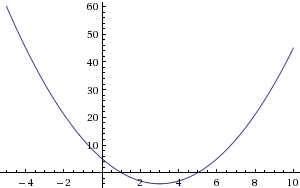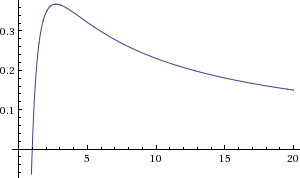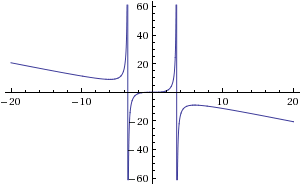חקירת פונקציות
נושא חקירת פונקציות בקורס חשבון אינפיניטיסימלי כוללת מחקר סט תכונות מוסכם (פחות או יותר):
- תחום הגדרה (קביעה באילו נקודות הפונקציה מוגדרת)
- זוגיות (קביעה האם הפונקציה זוגית, אי-זוגית או לא)
- תחומי מונוטוניות ומציאת נקודות קיצון
- תחומי קמירות ומציאת נקודות פיתול
- אסימפטוטות מאונכות
- נקודות חיתוך עם הצירים
- אסימפטוטות משופעות ומציאת התנהגות באינסוף
- תרפיה בתרשים- ציור גרף הפונקציה
הסברים ותרגילים על חקירת פונקציות
תרגילים
דוגמא 1: [math]\displaystyle{ f(x)=x^2-6x+5 }[/math]
תחום הגדרה
הגדרה: תהי [math]\displaystyle{ f(x) }[/math] פונקציה. תחום הגדרתה היא [math]\displaystyle{ A }[/math] - אוסף כל הנקודות בהם [math]\displaystyle{ f(x) }[/math] מוגדרת.
דוגמא: תחום ההגדרה של [math]\displaystyle{ f(x) }[/math] הוא כל הישר [math]\displaystyle{ \R }[/math] .
זוגיות/אי-זוגיות
הגדרה: [math]\displaystyle{ f(x) }[/math] תקרא זוגית אם [math]\displaystyle{ f(-x)=f(x) }[/math] .
הגדרה: [math]\displaystyle{ f(x) }[/math] תקרא אי-זוגית אם [math]\displaystyle{ f(-x)=-f(x) }[/math] .
דוגמא: [math]\displaystyle{ f(-x)=x^2+6x+5\not=\ \pm\ f(x) }[/math] ולכן [math]\displaystyle{ f(x) }[/math] אינה זוגית ואינה אי-זוגית.
חיתוך עם הצירים
החיתוך עם ציר [math]\displaystyle{ x }[/math] הן הנקודות [math]\displaystyle{ (1,0)\ ,\ (5,0) }[/math]
החיתוך עם ציר [math]\displaystyle{ y }[/math] היא הנקודה [math]\displaystyle{ (0,5) }[/math] .
נקודות קיצון ותחומי עליה/ירידה
הגדרה: תהא [math]\displaystyle{ f(x) }[/math] פונקציה. נאמר כי [math]\displaystyle{ f(x) }[/math] עולה (יורדת) בתחום [math]\displaystyle{ U }[/math] אם
[math]\displaystyle{ \forall x\lt y\in U:\ f(x)\le f(y) }[/math] או [math]\displaystyle{ \forall x\lt y\in U:\ f(x)\ge f(y) }[/math] .
הגדרה: תהי [math]\displaystyle{ f(x) }[/math] פונקציה. [math]\displaystyle{ x_0 }[/math] תקרא נקודת קיצון - מקס' (או מינ') אם קיימת לה סביבה [math]\displaystyle{ U }[/math] כך ש-
[math]\displaystyle{ \forall x\in U:f(x)\le f(x_0) }[/math] או [math]\displaystyle{ \forall x\in U:f(x)\ge f(x_0) }[/math] .
משפט: אם [math]\displaystyle{ f(x) }[/math] גזירה בנקודת קיצון [math]\displaystyle{ x_0 }[/math] אזי [math]\displaystyle{ f'(x_0)=0 }[/math] .
מסקנה: כדי למצוא נקודות קיצון של [math]\displaystyle{ f(x) }[/math] מספיק לבדוק מתי [math]\displaystyle{ f'(x)=0 }[/math] או מתי הנגזרת אינה קיימת כלל.
דוגמא - נמצא את הנקודות האפשריות לנקודות קיצון ל- [math]\displaystyle{ f(x) }[/math] :
[math]\displaystyle{ f'(x)=2x-6 }[/math] ולכן הנקודה החשודה היחידה היא [math]\displaystyle{ x_0=3 }[/math] .
מקס' או מיני'
איך יודעים אם מדובר בנקודות קיצון ואם מדובר בקיצון מקס' או בקיצון מיני'?
- בדיקת הפונקציה עצמה - הנקודות החשודות מחלקות את הישר לקטעים. נציב בכל קטע נקודה ונבדוק מה מתקבל: למשל נציב [math]\displaystyle{ f(0)=5\ ,\ f(3)=-4\ ,\ f(6)=5 }[/math] ולכן 3 נקודות מיני'.
הערה: אכן מספיק לבדוק נקודות אלו - כי אם הפונקציה היתה מחליפה מיקום (ביחס לנקודות החשודות) היכן שהוא אזי היתה נוצרת נקודת קיצון והיינו מגלים אותה בשלב הקודם.
- בדיקת ערכי הנגזרת - נבדוק את סימן הנגזרת מימין ומשמאל לנקודות (מסתמך על העובדה כי: אם [math]\displaystyle{ f'(x)\le0 }[/math] בקטע [math]\displaystyle{ I }[/math] אזי הפונקציה יורדת שם. אם [math]\displaystyle{ f'(x)\ge0 }[/math] אז הפונקציה עולה שם): [math]\displaystyle{ f'(0)\lt 0\ ,\ f'(4)\gt 0 }[/math] ולכן משמאל ל-3 הפונקציה יורדת ומימין ל-3 היא עולה, כלומר [math]\displaystyle{ x=3 }[/math] נקודת מיני'.
הערה: בשלב זה מצב כי תחום העליה של [math]\displaystyle{ f }[/math] הוא [math]\displaystyle{ [3,\infty) }[/math] ותחום הירידה [math]\displaystyle{ (-\infty,3] }[/math] .
הערה: אכן מספיק לבדוק נקו' אלו - כי אם הנגזרת היתה מחליפה היכן שהוא את סימנה אזי היתה נוצרת נקודת קיצון והיינו מגלים אותה בשלב הקודם.
- מבחן הנגזרת השניה - אם [math]\displaystyle{ f'(x_0)=0 }[/math] ומתקיים [math]\displaystyle{ f''(x_0)\gt 0 }[/math] (או [math]\displaystyle{ f''(x)\lt 0 }[/math]) אז [math]\displaystyle{ x_0 }[/math] נקודות מיני' (או מקס'):
אצלנו [math]\displaystyle{ f''(x)=2 }[/math] ולכן [math]\displaystyle{ f''(2)\gt 0 }[/math] .
תחומי קעירות/קמירות ונקודות פיתול
תהא [math]\displaystyle{ f(x) }[/math] גזירה בנקודה [math]\displaystyle{ x_0 }[/math] אזי נאמר שהפונקציה קעורה כלפי מעלה/מטה ב- [math]\displaystyle{ x_0 }[/math] אם קיימת סביבה [math]\displaystyle{ U }[/math] של [math]\displaystyle{ x_0 }[/math] כך שלכל [math]\displaystyle{ x\in U }[/math] מתקיים:
[math]\displaystyle{ f(x)\ge f'(x_0)(x-x_0)+f(x_0) }[/math] או [math]\displaystyle{ f(x)\le f'(x_0)(x-x_0)+f(x_0) }[/math] .
נאמר כי [math]\displaystyle{ x_0 }[/math] נקודת פיתול אם קיימת סביבה [math]\displaystyle{ U }[/math] ימנית בה [math]\displaystyle{ f(x)\ge f'(x_0)(x-x_0)+f(x_0) }[/math] וסביבה שמאלית [math]\displaystyle{ V }[/math] בה [math]\displaystyle{ f(x)\le f'(x_0)(x-x_0)+f(x_0) }[/math] או להפך.
משפט: [math]\displaystyle{ f''(x_0)\gt 0 }[/math] או [math]\displaystyle{ f''(x_0)\lt 0 }[/math] אז [math]\displaystyle{ f(x) }[/math] קעורה כלפי מעלה/מטה ב- [math]\displaystyle{ x_0 }[/math] .
משפט: הנקודות החשודות לפיתול הם הנקודות בהם [math]\displaystyle{ f''(x) }[/math] אינה קיימת או ש- [math]\displaystyle{ f''(x)=0 }[/math] .
דוגמא: [math]\displaystyle{ f''(x)=2 }[/math] ולכן אין נקודות פיתול והפונקציה קעורה כלפי מעלה בכל הישר.
אסימפטוטות
הגדרה: אסימפטוטה אנכית ל- [math]\displaystyle{ f(x) }[/math] היא קו מהצורה [math]\displaystyle{ x=a }[/math] כך שמתקיים [math]\displaystyle{ \lim\limits_{x\to a}|f(x)|=\infty }[/math] . אצלנו אין אסימפטוטה אנכית.
הגדרה: אסימפטוטה אופקית היא ישר [math]\displaystyle{ l(x)=ax+b }[/math] המקיים [math]\displaystyle{ \lim\limits_{x\to\infty}\Big|f(x)-l(x)\Big|=0 }[/math] או [math]\displaystyle{ \lim\limits_{x\to-\infty}\Big|f(x)-l(x)\Big|=0 }[/math] .
איך מוצאים? מתקיים [math]\displaystyle{ a=\lim\limits_{x\to\infty}\dfrac{f(x)}{x} }[/math] ואז [math]\displaystyle{ b=\lim\limits_{x\to\infty}\big[f(x)-ax\big] }[/math] .
דוגמא - אצלנו:
[math]\displaystyle{ \displaystyle a=\lim_{x\to\infty}\frac{f(x)}{x}=\lim_{x\to\infty}\frac{x^2-6x+5}{x}=\infty }[/math]
ולכן אין אסימפטוטה אופקית.
התנהגות הפונקציה באינסוף
עבור הדוגמא שלנו [math]\displaystyle{ \lim\limits_{x\to\pm\infty}f(x)=\infty }[/math]
דוגמא 2: [math]\displaystyle{ f(x)=\dfrac{\ln(x)}{x} }[/math]
תחום הגדרה
[math]\displaystyle{ x\gt 0 }[/math] כי [math]\displaystyle{ \ln(x) }[/math] לא-מוגדרת עבור [math]\displaystyle{ x }[/math]-ים שליליים.
זוגיות/אי-זוגיות
לא שייך בגלל תחום ההגדרה.
חיתוך עם הצירים
החיתוך עם ציר [math]\displaystyle{ x }[/math] הוא [math]\displaystyle{ (1,0) }[/math] .
החיתוך עם ציר [math]\displaystyle{ y }[/math] לא קיים בגלל תחום ההגדרה.
נקודות קיצון ותחומי עליה/ירידה
[math]\displaystyle{ f'(x)=\dfrac{1-\ln(x)}{x^2} }[/math] לכן יש לה נקודה חשודה ב- [math]\displaystyle{ x=e }[/math]
הסימן של [math]\displaystyle{ f'' }[/math] נקבע ע"י [math]\displaystyle{ -x-2x\big(1-\ln(x)\big)=-x\big(3-2\ln(x)\big) }[/math] .
[math]\displaystyle{ f(e)\lt 0 }[/math] ולכן זוהי נקודת מקס'.
תחומי העליה של הפונקציה [math]\displaystyle{ (0,e) }[/math] .
תחומי הירידה [math]\displaystyle{ (e,\infty) }[/math] .
תחומי קעירות/קמירות ונקודות פיתול
הסימן של [math]\displaystyle{ f'' }[/math] נקבע ע"י [math]\displaystyle{ -x\big(3-2\ln(x)\big) }[/math] ולכן נקודות חשודות לפיתול הם [math]\displaystyle{ e\sqrt{e} }[/math] .
[math]\displaystyle{ f''(e)\lt 0\ ,\ f''(e^4)\gt 0 }[/math] ולכן [math]\displaystyle{ e\sqrt{e}\approx 10 }[/math] נקודת פיתול.
הפונקציה קעורה כלפי מטה ב- [math]\displaystyle{ (0,e\sqrt{e}) }[/math] .
הפונקציה קעורה כלפי מעלה ב- [math]\displaystyle{ (e\sqrt{e},\infty) }[/math] .
אסימפטוטות
אסימפטוטה אנכית ב- [math]\displaystyle{ x=0 }[/math] כיון ש- [math]\displaystyle{ \lim\limits_{x\to0^+}f(x)=-\infty }[/math] .
אסימפטוטה אופקית:
[math]\displaystyle{ \begin{align}\displaystyle a=\lim_{x\to\infty}\frac{f(x)}{x}=\lim_{x\to\infty}\frac{\ln(x)}{x^2}=\lim_{x\to\infty}\frac{\frac1x}{2x}=0\\b=\lim_{x\to\infty}\big[f(x)-ax\big]=\lim_{x\to}\frac{\ln(x)}{x}=0\end{align} }[/math]
ולכן [math]\displaystyle{ l(x)=0 }[/math] אסימטוטה אופקית.
התנהגות הפונקציה באינסוף
עבור הדוגמא שלנו [math]\displaystyle{ \lim\limits_{x\to\infty}f(x)=0 }[/math]
דוגמא 3: [math]\displaystyle{ f(x)=\dfrac{x^3}{12-x^2} }[/math]
תחום הגדרה
[math]\displaystyle{ x\ne\pm2\sqrt3 }[/math]
זוגיות/אי-זוגיות
[math]\displaystyle{ f(-x)=\dfrac{-x^3}{12-x^2}=-f(x) }[/math] ולכן [math]\displaystyle{ f(x) }[/math] אי-זוגית.
נקודות קיצון
[math]\displaystyle{ f'(x)=\dfrac{3x^2(12-x^2)+2x^4}{(12-x^2)^2}=\dfrac{x^2(36-x^2)}{(12-x^2)^{2}} }[/math] ולכן הנקודות החשודות הן [math]\displaystyle{ x_0=0,\pm6,\pm2\sqrt3 }[/math]
(נשים לב שהנקודות [math]\displaystyle{ \pm2\sqrt3 }[/math] אינן נקודות קיצון כי אינן בתחום ההגדרה).
מקס' או מיני'
נשים לב שסימן הנגזרת נקבע לפי החלק של [math]\displaystyle{ 36-x^2 }[/math] :
[math]\displaystyle{ \begin{align}f'(-7)\lt 0\\f'(-6)=0\\f'(-4)\gt 0\\f'(-1)\gt 0\\f'(0)=0\\f'(4)\gt 0\\f'(6)=0\\f'(7)\lt 0\end{align} }[/math]
ולכן משמאל ל-6- הפונקציה יורדת ומימין ל-6- היא עולה, כלומר 6- נקודות מיני'.
6 נקודת מקס'.
0 אינה נקודת קיצון כי הפונקציה עולה גם מימין לה וגם משמאל.
תחומי קעירות/קמירות ונקודות פיתול
דוגמא:
[math]\displaystyle{ \begin{align}f(x)&=\dfrac{x^3}{12-x^2}\\f'(x)&=\dfrac{3x^2(12-x^2)+2x^4}{(12-x^2)^2}=\dfrac{x^2(36-x^2)}{(12-x^2)^2}\\f''(x)&=\dfrac{24x(12-x^2)(36+x^2)}{(12-x^2)^4}\end{align} }[/math]
הנקודות החשודות לפיתול הן [math]\displaystyle{ 0,\pm2\sqrt3 }[/math] . הסימן של [math]\displaystyle{ f''(x) }[/math] נקבע לפי החלק [math]\displaystyle{ x(12-x^2) }[/math] .
נבדוק:
[math]\displaystyle{ \begin{align}f''(-4)\gt 0\\f''(-1)\lt 0\\f(0)=0\\f(1)\gt 0\\f(4)\lt 0\end{align} }[/math]
ומכאן מסיקים כי -
בקטע [math]\displaystyle{ (-\infty,-2\sqrt3) }[/math] הפונקציה קעורה כלפי מעלה,
בקטע [math]\displaystyle{ (-2\sqrt3,0) }[/math] הפונקציה קעורה כלפי מטה,
בקטע [math]\displaystyle{ (0,2\sqrt3) }[/math] הפונקציה קעורה כלפי מעלה,
בקטע [math]\displaystyle{ (2\sqrt3,\infty) }[/math] הפונקציה קעורה כלפי מטה,
ובנקודה 0 יש נקודות פיתול (כי הנגזרת השניה שלילית עד אליה וחיובית ממנה).
אסימפטוטות
ל- [math]\displaystyle{ f(x)=\frac{x^3}{12-x^2} }[/math] יש 2 אסימפטוטות אנכיות ב- [math]\displaystyle{ x=\pm2\sqrt3 }[/math]
כי [math]\displaystyle{ \lim\limits_{x\to{-2\sqrt3}^+}f(x)=\lim\limits_{x\to{2\sqrt3}^+}f(x)=-\infty }[/math]
[math]\displaystyle{ \lim\limits_{x\to{-2\sqrt3}^-}f(x)=\lim\limits_{x\to{2\sqrt3}^-}f(x)=\infty }[/math]
אסימפטוטה אופקית:
[math]\displaystyle{ \displaystyle\begin{align}a=\lim_{x\to\infty}\frac{f(x)}{x}=\lim_{x\to\infty}\frac{x^3}{x(12-x^2)}=-1\\b=\lim_{x\to\infty}\left[\frac{x^3}{12-x^2}+x\right]=\lim_{x\to\infty}\frac{12x}{12-x^2}=0\end{align} }[/math]
באותו אופן גם אסימפטוטה לכיוון [math]\displaystyle{ x\to-\infty }[/math] תצא אותו דבר
ולכן [math]\displaystyle{ l(x)=-x }[/math] אסימפטוטה אופקית לשני הצדדים.
התנהגות הפונקציה באינסוף
עבור הדוגמא שלנו [math]\displaystyle{ \displaystyle\lim_{x\to\infty}\frac{x^3}{12-x^2}=\infty\ ,\ \lim_{x\to-\infty}\frac{x^3}{12-x^2}=-\infty }[/math]
ציור הפונקציה
משפטים לסיכום:
1) אם [math]\displaystyle{ f(x) }[/math] גזירה בנקודת קיצון [math]\displaystyle{ x_0 }[/math] אזי [math]\displaystyle{ f'(x_0)=0 }[/math] .
2) מבחן הנגזרת השניה - אם [math]\displaystyle{ f'(x_0)=0 }[/math] ומתקיים [math]\displaystyle{ f''(x_0)\gt 0 }[/math] אזי [math]\displaystyle{ x_0 }[/math] נקודת מיני'.
3) אם [math]\displaystyle{ f'(x)\le0 }[/math] בקטע [math]\displaystyle{ I }[/math] אזי הפונקציה יורדת שם. אם [math]\displaystyle{ f'(x)\ge0 }[/math] אזי הפונקציה עולה שם.
4) אם [math]\displaystyle{ f''(x_0)\gt 0 }[/math] אזי [math]\displaystyle{ f(x) }[/math] קעורה כלפי מעלה ב- [math]\displaystyle{ x_0 }[/math] .
מסקנה: הנקודות החשודות לפיתול הם הנקודות בהם [math]\displaystyle{ f''(x) }[/math] אינה קיימת או ש- [math]\displaystyle{ f''(x)=0 }[/math] .



